
First of all, let us start with another rant about terminology. No wonder folks get confused. "OSIS" sounds like a condition - something wrong. Oooo, you have halitosis. Oooo, you have anythingosis. Sounds bad. The osis part should have been "ness", a simple description of quality.
So think of kyphosis as kyphness. And think of lordosis as lordness.
Of course, anybody who knows the terminology will laugh at you. You can take it.
Can't? OK. OK. So we stick with lordosis and kyphosis. Just know that they are descriptions of shape and not diseases.
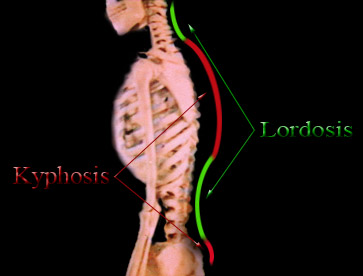 In terms of normal posture, the small of the back (alias the low back) curves into the body as a
hollow. That inward curvature is called lordosis.
In terms of normal posture, the small of the back (alias the low back) curves into the body as a
hollow. That inward curvature is called lordosis.
The part that sticks out, the round shoulders, in particular, is a shape called kyphosis. Beware, that round shoulders term messes everybody
up as the shoulders are not mid-line. The terms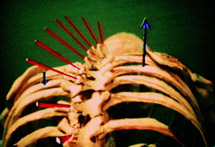 lordosis and kyphosis are
mid line contour descriptions. When the back sticks out because ribs are sticking out we do NOT use the term kyphosis. We call that ribs sticking out, from the Etruscan RibusStikusOutus. Way more often than not, the term kyphoscoliosis is just plain wrong as what is sticking out is ribs and typically the actual mid line spine shape is less kyphotic than normal.
lordosis and kyphosis are
mid line contour descriptions. When the back sticks out because ribs are sticking out we do NOT use the term kyphosis. We call that ribs sticking out, from the Etruscan RibusStikusOutus. Way more often than not, the term kyphoscoliosis is just plain wrong as what is sticking out is ribs and typically the actual mid line spine shape is less kyphotic than normal.
The most common cause of lordosis is being a toddler. After that comes being a girl. Girls often exaggerate their natural low back lordosis for allure.
While parents are nagging kids to stand straight, a poker straight spine is trouble. Old fusions with straight rods often are associated with a sense of being off balance.
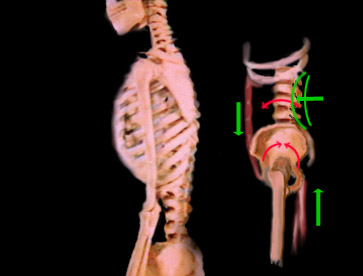 Extra low back (lumbar) lordosis may follow the abdominal muscles being weak or lazy. We see deep sway back standing that goes away on sitting.
Extra low back (lumbar) lordosis may follow the abdominal muscles being weak or lazy. We see deep sway back standing that goes away on sitting.
That's a huge clue. On standing, we tickle the belly - have to be a good tickler - and the belly pulls away. So? So, while the belly sucked in the back flattened.
Why? Because the pelvis is a sea-saw sitting on the two hips. Pull the pubis up and the low back flattens. Lower the pubis and the low back arches deeper - more lordosis.
Back muscles can directly stiffen the spine and straighten it but that is not the typical source of contour. The hamstring muscles (rear thigh muscles) pull the rear protruding lower pelvis (ishium) downward and thus straighten the lower spine.
Because the vertebrae are connected in a flexible rod like manner, when you straighten the lower back the shallower angle connection to the upper back tends to straighten that as well. Pulling in the gut flattens the upper (thoracic) kyphosis.
Now these are all generalities bases on normal anatomy and a reasonable range of flexibility.
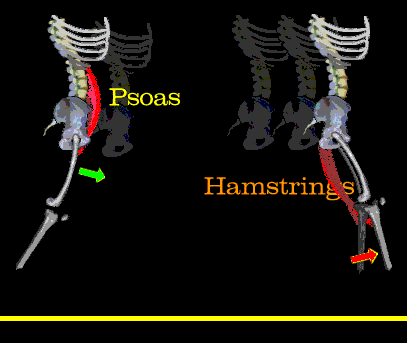 In babies, the lower spine, the
entire spine is kyphotic. Once the baby stands as a toddler, the short Psoas muscle (the powerful hip flexor) which attaches to the lower spine pulls the lower spine into lordosis.
In babies, the lower spine, the
entire spine is kyphotic. Once the baby stands as a toddler, the short Psoas muscle (the powerful hip flexor) which attaches to the lower spine pulls the lower spine into lordosis.
The interplay between Psoas, hamstrings and rectus abdominus muscles then determines the standing posture. The hip joint capsule (canvas-like covering) may be thickened and resist the extended standing posture. That, too, may lead to excessive lumbar lordosis by pulling the pelvis down from the front.
The upper end of the femur is cartilage in young children. The extension of the thighs in walking and play will deform the extra forward twist that the femur bone has at birth so as to lessen the in-turn of the legs and allow more hip extension. This works if the hip joint is sound and stable and the forces reasonable.
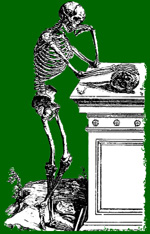 When things are really off...
When things are really off...
PATHOLOGY: